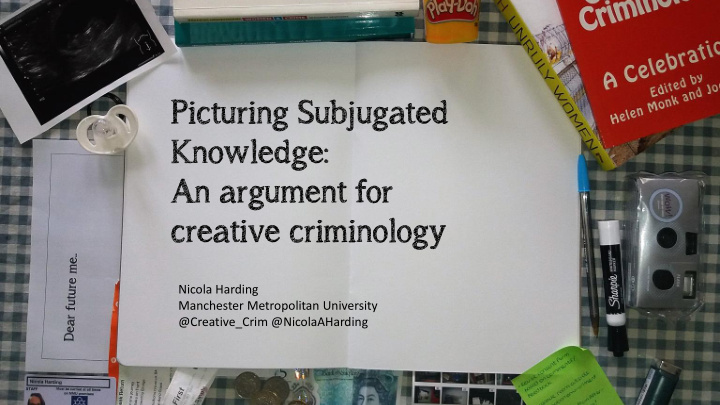



Picturing Subjugated Knowledge: An argument for creative criminology Nicola Harding Manchester Metropolitan University @Creative_Crim @NicolaAHarding
Picturing Subjugated Knowledge • Capturing the everyday experiences of criminalised women subject to community punishment and/or supervision. • Critical Feminist epistemology. • Feminist standpoint methodology with Participatory Action Research (PAR). • Creative methods – Photovoice, creative writing & narrative mapping. • Poses a challenge to some assumptions made in classical and contemporary theory. Implications for: theory, practice, and policy.
Just Images? Creativity, transformation & the visual turn.. ‘Creativity is any act, idea, or product that changes an existing domain, or that transforms an existing domain in to a new one. And the definition of a creative person is: someone whose thoughts or actions change a domain , or establish a new domain. It is important to remember, however, that a domain cannot be changed without the explicit or implicit consent of a field responsible for it’ ( Czikszentmihalyi, 1997, p. 28).
Feminist Criminology & the Visual Visual criminology has been developed as a response to the dominance of text as knowledge within criminology, just as feminist criminology is a response to the problem of generalization and the androcentric nature of criminology. ‘brings attention to overlooked dimensions of crime and power relationships underpinning mainstream criminology’ ( Henne & Shah, 2016, p. 2). A creative criminology offers analysis of the structures within which crime is created, inequalities replicated, and offers a critical mirror within which criminology as a discipline can reflect upon its limitations.
Participatory Action Research
Doubting Desistance Theorist Desistance Theory This study Laub & Sampson (2003) Life course approach / adult All of the 28 women in the study reported transitions . experiencing domestic violence. Yet probation ‘The love of a good woman’ officers encouraged women in to settled relationships to reduce risk. Gottfredson and Hirschi Self-control & Maturation. This study included first time offenders in late (1990) Prioritises internal factors 40s and mid-50s. None of the women in the and individual maturation study had been juvenile offenders, were processes mature & had enormous responsibility in their lives. Maruna (2001) Identity & Change. ‘.. that process [of criminalisation] does not Condemnation & define me, I will not let it, I am not a bad Redemption scripts. person. What I did was… it wasn’t me solely and it is not me as a person, I am not that person’ Sarah, Peer Mentor (2016)
Creative Criminology • Path has been forged by visual criminology & trends towards multi-disciplinary research. • Ideal for feminist research due to the challenge to hierarchies of knowledge it presents. • Compliments the transformative nature of participatory action research. • Facilitates knowledge production from the ‘bottom - up’. • Challenges existing theories of crime, deviance, and rehabilitation.
References • Carrabine, E. (2012). Just images: Aesthetics, ethics and visual criminology. British Journal of Criminology. https://doi.org/10.1093/bjc/azr089 • Gottfretson, M. R., & Hirschi, T. (1990). A General Theory of Crime. Stanford: Stanford University Press. • Henne, K., & Shah, R. (2016). Feminist Criminology and the Visual. In Oxford Research Encyclopedia, Criminology and Criminal Justice. Oxford: Oxford University Press. • Laub, J. H., & Sampson, R. J. (2003). Shared Beginnings, Divergent Lives: Delinquent Boys to Age 70. Cambridge, MA: Harvard University Press. • Maruna, S. (2001). Making Good: How ex-convicts reform and rebuild their lives. London: American Psychological Association.
Recommend
More recommend